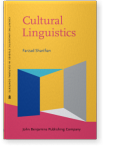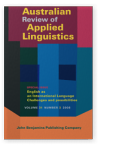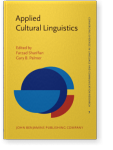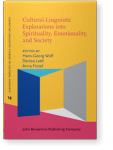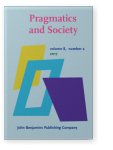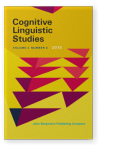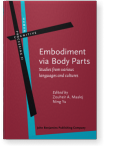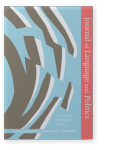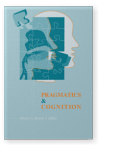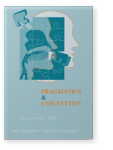Farzad Sharifian †
List of John Benjamins publications for which Farzad Sharifian † plays a role.
Journal
Book series
Cultural Linguistics: Cultural conceptualisations and language
Farzad Sharifian †
[Cognitive Linguistic Studies in Cultural Contexts, 8] 2017. xvii, 171 pp.
Subjects Anthropological Linguistics | Cognition and language | Discourse studies | Pragmatics | Semantics
Cultural Conceptualisations and Language: Theoretical framework and applications
Farzad Sharifian †
[Cognitive Linguistic Studies in Cultural Contexts, 1] 2011. xvii, 238 pp.
Subjects Anthropological Linguistics | Cognition and language | Discourse studies | Pragmatics | Semantics
English as an International Language: Challenges and possibilities
Edited by Michael Clyne and Farzad Sharifian †
Special issue of Australian Review of Applied Linguistics 31:3 (2008) 98 pp.
Subjects Applied linguistics | Corpus linguistics | Discourse studies | Language acquisition | Language policy | Language teaching | Multilingualism | Pragmatics | Translation Studies | Writing and literacy
Applied Cultural Linguistics: Implications for second language learning and intercultural communication
Edited by Farzad Sharifian † and Gary B. Palmer
[Converging Evidence in Language and Communication Research, 7] 2007. xiv, 170 pp.
Subjects Cognition and language | Communication Studies | Language acquisition
2021 Cultural Linguistics and religion Cultural-Linguistic Explorations into Spirituality, Emotionality, and Society, Wolf, Hans-Georg, Denisa Latić and Anna Finzel (eds.), pp. 9–22 | Chapter
Spiritual systems such as religions embody particular worldviews or systems of conceptualizing life, death, morality, creation, the life hereafter, fate, and so on. Since these conceptualizations are more or less shared across any speech community that believes in the same faith, religions can be… read more
2019 Conceptualisations of xoshbaxti (‘happiness / prosperity’) and baxt (‘fate / luck’) in Persian Journal of Historical Pragmatics 20:1, pp. 78–95 | Article
This paper explores conceptualisations of xoshbaxti (‘happiness / prosperity’) and baxt (‘fate / luck’) in Persian, adopting a combined historical and contemporary analysis. The expression xoshbaxti consists of the free morphemes xosh (‘pleasant’) and baxt (‘fate’). The root of baxt originates… read more
2018 Cross-cultural conceptualizations of ageing in Australia Cognitive Linguistic Studies 5:2, pp. 261–281 | Article
In this paper, the framework of Cultural Linguistics is employed to examine how older people from two different ethnic backgrounds in Australia conceptualize ageing and their own experience of ageing. The paper employs a qualitative method for the instantiations of interviews from two focus… read more
2017 Perception of (im)politeness and the underlying cultural conceptualisations: A study of Persian Pragmatics and Society 8:2, pp. 231–253 | Article
The present study sets out to investigate the role of ‘culture’ as one of the many important factors that influence the evaluation of (im)politeness in Persian from a Cultural Linguistics perspective. The paper argues that Cultural Linguistics, and in particular the notion of cultural schema,… read more
2017 Unpacking cultural conceptualizations in Chinese English Journal of Asian Pacific Communication 27:1, pp. 65–84 | Article
Considerable depth and breadth of research on Chinese English has been undertaken over the last three to four decades, contributing to the epistemological advancement of a number of academic disciplines, including world Englishes, Intercultural Communication, and Cultural Linguistics.… read more
2015 Conceptualizations of damâ, “temperature” in Persian: A Cultural Linguistic study Cognitive Linguistic Studies 2:2, pp. 239–256 | Article
This paper examines conceptualizations of temperature in contemporary Persian, from the perspective of Cultural Linguistics. Several expressions in which temperature terms are used reflect cultural metaphors where temperature is used as a source domain for conceptual mapping to the domain of… read more
2014 International Journal of Language and Culture International Journal of Language and Culture 1:1, pp. 1–4 | Article
2011 Conceptualizations of cheshm ‘eye’ in Persian Embodiment via Body Parts: Studies from various languages and cultures, Maalej, Zouheir and Ning Yu (eds.), pp. 197–212 | Article
Common Persian expressions containing cheshm ‘eye’ convey conceptualizations of emotions, including love, envy, and greed, as well as denote character traits such as naiveté and willfulness. This body part is also associated with a Persian cultural schema that equates ‘eye do’ or ‘eye hit’, with… read more
2009 Figurative language in international political discourse: The case of Iran Journal of Language and Politics 8:3, pp. 416–432 | Article
Figurative language is used in all domains of communication, including political discourse. And since figurative language is largely socio-culturally constructed it presents a significant locus for misinterpretation or even manipulation when it collides with the realm of international politics.… read more
2008 English as an international language: Challenges and possibilities English as an International Language: Challenges and possibilities, Clyne, Michael and Farzad Sharifian † (eds.), pp. 28.1–28.16 | Miscellaneous
In recent years, there has been a rapid evolution in the demographics of English speaking communities and individuals around the world, with an unprecedented growth in the number of users and learners of English. In the majority of cases, these learners and users are those who would traditionally… read more
2008 English as an international language: Synthesis English as an International Language: Challenges and possibilities, Clyne, Michael and Farzad Sharifian † (eds.), pp. 36.1–36.19 | Miscellaneous
2007 1. Applied cultural linguistics: An emerging paradigm Applied Cultural Linguistics: Implications for second language learning and intercultural communication, Sharifian, Farzad † and Gary B. Palmer (eds.), pp. 1–14 | Chapter
2007 3. L1 cultural conceptualisations in L2 learning: The case of Persian-speaking learners of English Applied Cultural Linguistics: Implications for second language learning and intercultural communication, Sharifian, Farzad † and Gary B. Palmer (eds.), pp. 33–51 | Chapter
This chapter presents the argument that second language learning is likely to involve new systems of cultural conceptualisations, that is, new cultural schemas, categories, metaphors, etc. By providing examples from Persian-speaking learners of English the chapter discusses how L2 learners may draw… read more
2005 The Persian cultural schema of shekasteh-nafsi: A study of compliment responses in Persian and Anglo-Australian speakers Pragmatics & Cognition 13:2, pp. 337–361 | Article
This study is as an attempt to explicate the Persian cultural schema of shekasteh-nafsi ‘modesty’. The schema motivates the speakers to downplay their talents, skills, achievements, etc. while praising a similar trait in their interlocutors. The schema also encourages the speakers to reassign the… read more
2003 The pragmatic marker like in English teen talk: Australian Aboriginal usage Pragmatics & Cognition 11:2, pp. 327–344 | Article
This study reports on the use of like in Aboriginal English teen talk. The analysis of a sub-corpus of 40 adolescent texts from a corpus of 100 narratives by speakers of Aboriginal English in Western Australia revealed that like is often employed by these speakers, and that it achieves a multitude… read more


